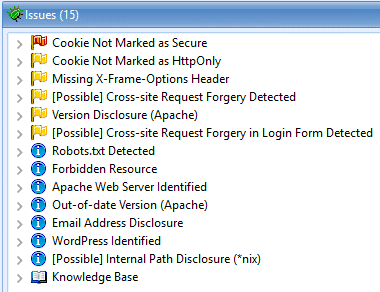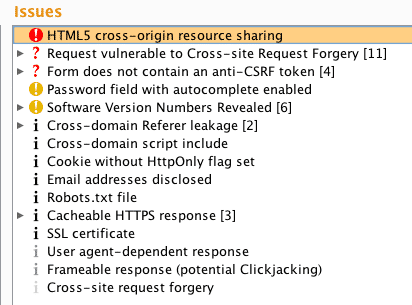[ Web Scanner Series ] Burp vs. Netsparker

In this series I’m going to be taking a look at how various web scanners perform at finding web application security issues.
This installment compares Burpsuite Pro > with Netsparker.
Settings
I am going to be using default settings for the most part with the following caveats:
Netsparker is an automated scanner and thus it performs content discovery and spidering on its own
Burp is a manual testing tool, and these steps are done separately within it
For this reason, I performed a basic (default) spider of the site in question using Burp. The only setting changed was disabling the submission of login forms
No authentication was set in Netsparker either
I have a number of extensions installed in Burp, but nothing was done with those extensions. In other words, if they worked automatically or passively then they worked, but nothing manual was done with them
I also ran a Content Discovery session using Burp from the Engagement Tools. I let it run for about 10 minutes, which is roughly how long it took Netsparker to finish its scan. This is not a direct comparison because, like I said, the tools handle this type of activity quite differently
The test site
The test site is an updated WordPress installation with around 50 articles in it. I used something that was updated and relatively small so that the scans could complete quickly.
I also wanted to use a real site rather than a test/vulnerable install because it’s more representative of reality. I am aware that WordPress sites don’t represent enterprise applications, or custom applications, or MANY other things.
This what I chose to use, however, as a matter of practicality, and the amount of surface area (allowing the tools to highlight their checks) is better than one might expect.
The test site is on a fast host and happens to be quite responsive, so the tests completed in around 10 minutes.
Methodology
First, don’t get too excited. This isn’t a formal test. I’m not keeping strict logs. It’s pretty loose.
Configuration
For Burp, I had to do a few separate things: set the site scope, spider, discover content, and then perform an active scan. This was not required in Netsparker because it’s a point-and-shoot tool that does all three of these automatically
I gave nothing but a starting URL to both tools, i.e. no manual browsing to prime Burp
I used extensions in Burp because they’re available and can easily be installed. I would have done the same for Netsparker if it had that functionality
As mentioned above, I had to stop Burp’s discovery session because even though I disabled long directory and file guessing (the only change I made to that module), it still would have run for a very long time. I wanted to see what it could get in the time it took Netsparker to get what it did
For the Active Scanner phase in Burp, I removed duplicate URLs, removed items with no parameters, and removed js, gif, jpg, png, and css extensions (a default recommendation)
All other settings were left at defaults, including scanner tuning, thread counts, etc.
Results
Here are the Netsparker results:

And here are the Burp results:

Analysis
Here are the major takeaways for me:
Both tools found roughly the same number of findings (which is a mostly useless metric)
Burp missed a cookie not marked as secure
Both tools were fooled by a fake Apache Server header
Both tools found significant CSRF issues
Netsparker highlighted a forbidden resource (403), and Burp did not
Netspaker correctly identified the site was running WordPress, Burp did not
Burp identified cacheable SSL responses, Netsparker did not
Burp identified a user-agent varied response (standard browser vs. mobile browser), and highlighted the difference.
Burp highlighted an email address disclosure
Burp highlighted cross-domain script includes, Netsparker did not
Burp highlighted cross-domain referer leakage, Netsparker did not
Burp highlighted a password field with autocomplete enabled, Netsparker did not
Burp found HTML5 cross-origin resource sharing, Netsparker did not
As you might have guessed, it’d have been nice to have both sets of results. Both found (and/or alerted on) things that the other did not.
A couple of things I noticed:
It’s quite nice to have the content discovery and spidering done automatically by the fully automated tool, when you’re looking for that type of functionality
The actual Active Scan portion of the Burp testing only took a few seconds, whereas it took Netsparker far longer (but keep in mind it did it all at the same time)
I think Burp would benefit greatly from a point-and-shoot option that would put it on par with scanners like WebInspect, AppScan, and Netsparker. It hurts my sensibilities as a manual tester, but there’s no logical reason it should lack features compared to its competitors
Summary
This was purposely a test of scanner technology. If I were performing an actual assessment (be sure not to confuse the two) the results would massively favor Burp because it’s a tool for helping testers do manual work, where Netsparker is not.
My preference for the results leans toward Burp. I think the HTML5 result was a big one. I like how quickly it found what it found. And I generally prefer using the automated functionality of Burp to other tools because it’s all happening within a manual testing tool.
That being said, I think Netsparker did really well. It found extremely similar content and did it with virtually no configuration.
Anyway, hope this helps someone. I’m going to be doing more of these comparisons using various tools, and many of the comparisons will include manual vs. automated findings, results after optimizing settings (as opposed to using defaults), etc.
Notes
I speak regularly with Daf (the author of Burp), and he’s aware of the various points in this piece. No surprises here. If you think you’re telling him some new and great feature, he’s probably had it on the backlog for several years. It takes time to put new features in, and prioritization is a constant challenge. I for one think he and the team are doing a spectacular job.
Here are the Burp extensions I had installed: Autorize, Identity Crisis, Image Location Scanner, Intruder File Payload Generator, Retire.js, Site Map Fetcher, J2EEScan, HTML5 Auditor, Bypass WAF, Content Type Converter, .NET Beautifier, Error Message Checks, Authz, JS Beautifier, Session Auth, Active Scan++, Additional Scanner Checks, SQLiPy, JSON Decoder, Reflected Parameters, Software Version Reporter, Headers Analyzer, Session Timeout Test, CSRF Scanner
I’m not going to be going overboard with these analysis pieces, but if you have something you’d really like to see in here let me know. I’m keeping them very short and quick, but am happy to add an analysis section if it’s important to people.